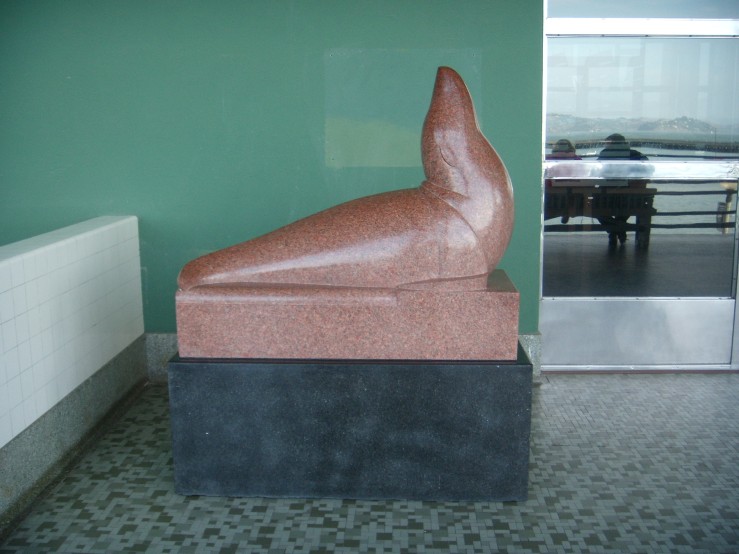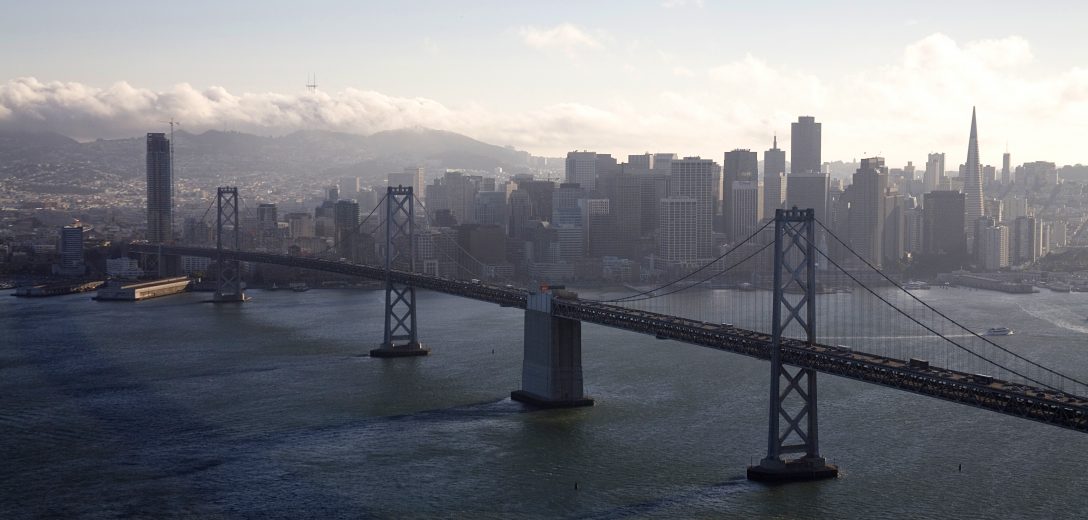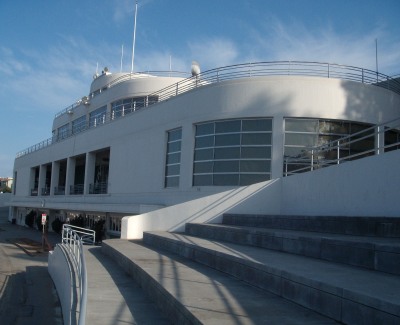
San Francisco may be famous for its Victorian row houses and over-the-top Queen Annes, but it is also home to one of the most notable examples of a building in the Streamline Moderne style. The ship-like Bathhouse building, which sits in its berth at Aquatic Park is a great example of the style, which became more popular in the 1930s, and often features nautical references.
As the Great Depression went on, the concept of streamlining, creating clean, sleek lines seemed more in tune with the austere times. But it wasn’t just the economy, there were other influences too, such as Norman Bel Geddes and his industrial designs meant to evoke movement and speed. There was also a growing influence of the European architects who espoused a sparer form of modernism, dubbed the International Style, and many of them moved to the U.S. to teach or work.
The Aquatic Park bleachers and Bathhouse, now the Maritime Museum and operated by the National Park Service have been undergoing a major $13.8 million rehab project over the last year, the bulk of which is now finished. The bleachers, some of which had to be demolished and others rebuilt, were finished this summer and reopened to the public, and the restoration of the stunning murals in the Bathhouse lobby is now complete. The building is an architectural feast for the eyes for anyone enamoured with this period of design, and it contains a treasure trove of public art.

WPA Project
Originally designed as a public bathhouse, beach and playground at the sea, Aquatic Park also includes an 1800 foot curving pier. It survives as an example of both a triumph and a travail of the city and the Works Progress Administration. In 1917, the city bought the land at the bottom of Van Ness from the Southern Pacific Railroad, but legal technicalities held up the work. Construction first began in 1931 on the combination breakwater and pier, by a private construction firm, working for the city’s Parks Commission. The project, however, languished. After the election of President Franklin Delano Roosevelt, much of the work moved to the WPA, which began work on the seawall in December, 1935. Architect William Mooser III of the city’s Mooser architectural dynasty, designed the bathhouse as assistant district director of the WPA.
The project, which cost $1.2 million, finally opened in January, 1939, after much public grumbling. The San Francisco Chronicle tried to calm the city in an editorial on July 24, 1936. “It is quite natural for the public to become impatient with the progress of public works…The difficulty is accentuated when construction projects are undertaken by such governmental organizations as WPA.” Five months after the opening, the WPA was called back in, and built a sewage pumping plant, a playground, convenience stations and added stainless steel around the plate glass windows and doors.

The building’s flat roofs and terraces were the root cause of its water damage and need for the lengthy repairs, but it was worth the wait. The murals have also been cleaned and restored. On the first floor, the colorful walls depict an underwater world like Atlantis painted by artist Hilaire Hiler, who created 5,000 square feet of submerged continents and mythical sea creatures. Just outside on the terrace, beyond the plate glass doors that mirror the bay, there is more art. San Francisco sculptor Beniamino Bufano carved a seal and a frog in his round, inviting forms.


Artist Sargent Johnson, who also worked with architect Timothy Pflueger on the athletic frieze at George Washington High School – where he replaced Bufano who was fired – did some unusual tile mosaics in the same manner as mosaics in Islamic mosques. Johnson also sculpted the slate that surrounds the entrance to the Bathhouse building. Johnson said in an oral history with the Smithsonian Institution’s Archives of American Art that he wasn’t quite sure what the subject matter of the facade was. “It has something to do with the waterfront somewhere, boats – I don’t really know. I just carved the thing,” he said. At the time of the interview, which took place in 1964, Johnson, who was 76, and Mary McChesney, who conducted the interview, discussed how the murals in the Bathhouse were peeling, water was coming down the walls and they were rotting. They would be pleased to see the restoration today.



Absolutely love this building, and its associated art. It’s a highly recommended stop for visitors to San Francisco, and a “must see” for locals. The pier must be visited too, and the Balclutha!
I got to see the 2nd floor last week on a tour with the NPS docent. It’s not open to the public however. Have to go on tour.
There is a great mural in the lobby/anteroom of the woman’s bathroom.
Saw Aquatic Park in new Clint Eastwood movie “Hereafter.”
Awesome! Another reason to see that movie I guess.